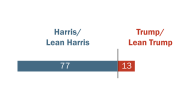Latinos lag significantly behind whites in home broadband access. Some 45% of Latinos have a home broadband connection, compared with 65% of whites. Latinos also lag behind blacks, 52% of whom have a home broadband connection. These gaps in broadband access are not driven simply by variations in internet use—even among internet users, Hispanics lag significantly behind whites and blacks. Some 69% of Hispanic internet users report that they have a home broadband connection, compared with 84% of white users and 78% of black users.
Controlling for educational attainment eliminates the ethnic differences in home broadband access. This indicates that the broadband differences are related to differences in educational attainment between these groups.
The ethnic differences in home broadband access also disappear when controlling for income, with one exception. Among those earning less than $30,000 annually, whites are still more likely than Hispanics to have a broadband connection at home (45% vs. 33%).
Six-in-ten (60%) native-born Hispanics have a home broadband connection, while among the foreign born, this share is 35%. The stark nativity differences in internet use are not fully responsible for this variation. Even among internet users, the native born are more likely than the foreign born to have home broadband access (74% vs. 64%).
In terms of language, Latinos who are Spanish dominant are the least likely to have a home broadband connection—just one-fourth (26%) do. In comparison, two-thirds (66%) of English-dominant Latinos and 52% of bilingual Latinos report a home broadband connection. These language differences persist when limiting the analysis to internet users.
Latinos ages 60 and older are significantly less likely than younger Latinos to have a home broadband connection. While one-in-five (20%) older Latinos had home broadband in 2010, this share reached 61% for Latinos 18 to 29. It is 49% for those ages 30 to 44, and 38% for Latinos 45 to 59.4 Virtually all of these differences disappear when the analysis is limited to internet users, indicating that the age differences in broadband use are due almost entirely to age differences in the likelihood of being online.
Only 19% of Hispanics with less than a high school diploma have a home broadband connection, but this share rises to 44% for high school graduates. Among Hispanics with at least some college education, more than three-fourths (77%) have home broadband access. These differences in home broadband access are not due simply to educational differences in internet use in general. Limiting the sample to internet users shows that users with higher levels of education are significantly more likely than less educated users to have home broadband. Some 46% of users with less than a high school diploma have a home broadband connection, compared with 66% of high school graduates and 84% of those with some college education.
Household income, too, is positively linked with having a home broadband connection. One-third (33%) of Latinos with a household income under $30,000 have home broadband access. Among Latinos in households with incomes of $30,000 to $49,999, over half (56%) have broadband access. And fully 82% of Latinos in households with incomes of at least $50,000 had home broadband access in 2010. As with education, these income differences persist when analysis is limited to internet users. Some 57% of internet users with household incomes less than $30,000 have home broadband, as do 71% of those with incomes of $30,000 to $49,999. Home broadband access reaches 90% for Hispanics with household incomes of $50,000 or more.
Hispanics are equally likely to have broadband access whether they live in an urban, suburban or rural area. Some 45% of Hispanics living in cities have home broadband access, as do 48% of those in suburbs and 41% of those living in rural areas.





